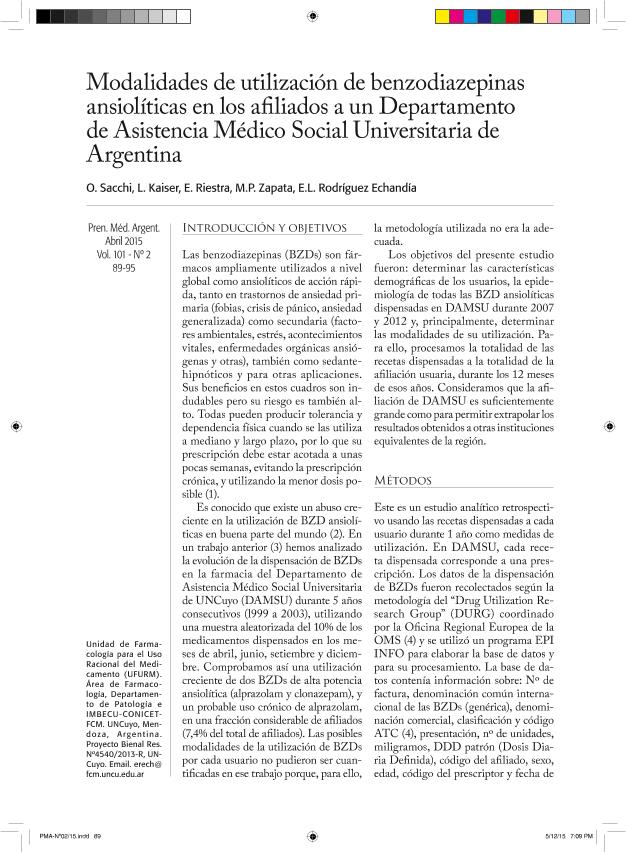Mostrar el registro sencillo del ítem
dc.contributor.author
Sacchi, Osvaldo Jorge

dc.contributor.author
Kaiser, L.
dc.contributor.author
Riestra, M. P.
dc.contributor.author
Zapata, Maria Patricia

dc.contributor.author
Rodriguez Echandia, Eduardo Luciano

dc.date.available
2018-04-12T18:42:17Z
dc.date.issued
2015-04
dc.identifier.citation
Sacchi, Osvaldo Jorge; Kaiser, L.; Riestra, M. P.; Zapata, Maria Patricia; Rodriguez Echandia, Eduardo Luciano; Modalidades de utilización de benzodiazepinas ansiolíticas en los afiliados a un Departametno de Asistencia Médico Social Universitaria de Argentina; Ediciones Médicas del Sur; La Prensa Médica Agentina; 101; 2; 4-2015; 89-95
dc.identifier.issn
0032-745X
dc.identifier.uri
http://hdl.handle.net/11336/41887
dc.description.abstract
Las benzodiazepinas (BZDs) son fármacos ampliamente utilizados a nivel global como ansiolíticos de acción rápida, tanto en trastornos de ansiedad primaria (fobias, crisis de pánico, ansiedad generalizada) como secundaria (factores ambientales, estrés, acontecimientos vitales, enfermedades orgánicas ansió genas y otras), también como sedantehipnóticos y para otras aplicaciones. Sus beneficios en estos cuadros son indudables pero su riesgo es también alto. Todas pueden producir tolerancia y dependencia física cuando se las utiliza a mediano y largo plazo, por lo que su prescripción debe estar acotada a unas pocas semanas, evitando la prescripción crónica, y utilizando la menor dosis posible.
dc.description.abstract
This is an analytical retrospective study on benzodiazepines (BZDs) prescription in the DAMSU´s affiliation along years 2007 and 2012 to identify demography of users, epidemiology of all dispensed ansiolytic BZDs and the modalities of their use. The total prescription orders delivered in these years were recorded according to the DURG methodology. The total mg/user/year and the DDDs/ year of the BZDs dispensed to each user were considered as a measure of utilization. The total DAMSU´s affiliation was 24684 in 2007, this grown to 26097 in 2012. The BZDs users were 15.4% of the total affiliation in 2007 and 17.4% in 2012. In both years, almost 90% of users aged 40 to 80 years with a maximal prevalence between 60 and 79 years. A 63.8 of users were females, so males rounded 36% only (difference P<0.01). In 2007, 8 BZDs were prescribed and the ranking was alprazolam> clonazepam>diazepam>.lorazepam>broma zepam>chlorazepate>clobazan>oxazepam. In 2012 the same BZDs were prescribed but clonazepam headed the ranking followed by alprazolam, the rest was similar. Grouping the users of clonazepam together with those of alprazolam they reached the 79.7% of the total users of BZDs in 2007 and the 85.3% in 2012. As to the modalities of BZDs consumption, the users with a dispensation up to the 6th part of the corresponding DDD/year were grouped as BZD “low users”. The clonazepam users dispensed with 1 or 2 prescription orders in the year were more than 64% and the amount of the low diazepam users was 51%. Percentages of low users of the rest of BZDS were less than 30%. This group was considered as occasional users, then not dependent of BZDs consumption. Were considered as “intermediate consumption users” those that were dispensed with up to 66% of the corresponding DDD/ year; these would represent the frequent utilization users. The group identified as “high utilization users” was dispensed with about the corresponding DDD/year. This comprised the almost permanent users in doses equivalent to those indicated in ATC. Finally, the group enclosing the “excessive utilization users” was the one of permanent users with doses much higher than the corresponding DDD/year. In this group the percentage of alprazolam users (22.5%) and lorazepam (17%) significantly surpassed those of the rest of BZDs. Joining together the percentages of “high” and “excessive” users of clonazepam (6.7% only) and diazepam (17.0%) these were significantly lower than those of the rest of BZDs. Results suggest that these two BZDs have the less addictive potential, and would provide less consumption dependence than the other BZDs.
dc.format
application/pdf
dc.language.iso
spa
dc.publisher
Ediciones Médicas del Sur
dc.rights
info:eu-repo/semantics/openAccess
dc.rights.uri
https://creativecommons.org/licenses/by-nc-sa/2.5/ar/
dc.subject
Benzodiazepinas
dc.subject.classification
Otras Ciencias de la Salud

dc.subject.classification
Ciencias de la Salud

dc.subject.classification
CIENCIAS MÉDICAS Y DE LA SALUD

dc.title
Modalidades de utilización de benzodiazepinas ansiolíticas en los afiliados a un Departametno de Asistencia Médico Social Universitaria de Argentina
dc.type
info:eu-repo/semantics/article
dc.type
info:ar-repo/semantics/artículo
dc.type
info:eu-repo/semantics/publishedVersion
dc.date.updated
2018-03-27T13:34:52Z
dc.journal.volume
101
dc.journal.number
2
dc.journal.pagination
89-95
dc.journal.pais
Argentina

dc.journal.ciudad
Mendoza
dc.description.fil
Fil: Sacchi, Osvaldo Jorge. Consejo Nacional de Investigaciones Científicas y Técnicas. Centro Científico Tecnológico Conicet - Mendoza. Instituto de Medicina y Biología Experimental de Cuyo; Argentina
dc.description.fil
Fil: Kaiser, L.. Universidad Nacional de Cuyo; Argentina
dc.description.fil
Fil: Riestra, M. P.. Universidad Nacional de Cuyo; Argentina
dc.description.fil
Fil: Zapata, Maria Patricia. Consejo Nacional de Investigaciones Científicas y Técnicas. Centro Científico Tecnológico Conicet - Mendoza. Instituto de Medicina y Biología Experimental de Cuyo; Argentina
dc.description.fil
Fil: Rodriguez Echandia, Eduardo Luciano. Consejo Nacional de Investigaciones Científicas y Técnicas. Centro Científico Tecnológico Conicet - Mendoza. Instituto de Medicina y Biología Experimental de Cuyo; Argentina
dc.journal.title
La Prensa Médica Agentina
dc.relation.alternativeid
info:eu-repo/semantics/altIdentifier/url/http://www.prensamedica.com.ar/rev_arc.html
Archivos asociados
